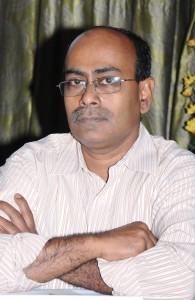The idea of weaving brings back the Rumpelstiltskin story to one’s head. With one subtle but important difference – Unlike this famous fairytale in real life a happy ending calls for much more than guessing a weird sounding name. For families of weavers, tens and thousands of them in India, their saviour came in the form of a path breaking invention called the Carding Machine.
Fabric production today is a tedious process. It involves various stages, such as picking up cotton and then separating lint, the basis of cotton fabric, from seed. Lint is then processed into yarn in a series of mechanical interventions. A carding machine simplifies the process. It is portable; it helps take cotton from the grower, filter it for fibre and converts fibre to yarn by feeding it into a frame. Who is the man behind the machine? IIT Madras alumnus Kannan Lakshminarayan.

Why did this engineer from IIT get into the handloom sector in the first place? For Kannan, the reason was to create value in society through what he had learnt in his engineering. He explains,
“I was associated with different groups working in the area of rural development, including those doing ‘constructive’ work and protest movements like Narmada Bachao Andolan. I saw the connectedness between problems of poverty, environment destruction and people’s control over factors that affect their lives. Perhaps because of my engineering education, I related these to the issue of how knowledge production and its legitimisation in society. This led me to look for inclusive ways in which people could participate creatively to create value in society. Artisan-based industries seemed to hold the answers, and this logically led me to the biggest such industry – handlooms.”
In spite of being credited with this revolutionary invention, Kannan is as humble as a man can be. When asked what was the biggest challenge he faced in inventing the carding machine, he points out without hesitation that it was his ‘incompetence’. It was probably the magnitude of the task he had taken up that made him feel that way. “I was attempting something very difficult, something that no one had succeeded in since the Industrial Revolution. On the other hand, I had no working experience as an engineer. The good thing was that I had no money. So I ended up having to do things very ingeniously, in a bootstrapped way. I worked closely with user-groups, involved them as much as possible in the process of development, so that the results are aligned with their needs. Such a process takes a long time, but delivers more per rupee spent – especially when a good part of the spend goes into upgrading my own competence,” says Kannan.
As a result of his invention, handloom weavers at the grassroots are exposed to simple and efficient technology that they can easily use. In what is called the malkha process, they find an alternative to the present situation where both farmers and weavers are dependent on spinning mills. The mills make high-twist yarn for mechanical weaving, while handlooms can use yarn with less twist which would give the cloth better absorbency and colour holding. The handloom’s great advantage in the market of its huge diversity – each region has its particular weaves – is lost when handlooms everywhere have to use the same mill-spun yarn. Also, using the carding machine in the pre-spinning stage, instead of the heavy machinery of the conventional process is a much better option for the villagers. The process provides an economical shortcut by bypassing processes like baling, unbaling and blow-room involved in textile production.
For Kannan, inventing the carding machine was not the end of the road; it was just a beginning. Today, Kannan is also the managing trustee of the Chennai-based Fractal Foundation, a non-profit less than two years old, addressing the cause of returning textile production to the community. He is also the founder of Vortex, a company that manufactures machines involved in the Decentralized Cotton Yarn (DCY) Technology that lies at the heart of the Malkha process. The entire machinery costs 14 lakhs but generates savings of much more in terms of value and output per unit of input.
What is that attracts Kannan to technology and constantly striving to improve upon it? “I guess I am inherently lazy — want to get maximum fruits with minimum effort. Technology seemed to me like a right candidate for such a temperament: you formulate a problem as generically as is practical, develop a solution for it and then it multiplies in impact manifold!” He also admits to being a daydreamer. What is his next big dream? “A persistent dream in the recent past has been the idea of imparting cost-effective skill education through virtual reality platforms,” says Kannan.
For more on the Malkha Process and how it is changing lives, visit http://malkha.in/process.html and www.malkhaindia.blogspot.com.
If you found our stories insightful, informative, or even just enjoyable, we invite you to consider making a voluntary payment to support the work we do at The Better India. Your contribution helps us continue producing quality content that educates, inspires, and drives positive change.
Choose one of the payment options below for your contribution-
By paying for the stories you value, you directly contribute to sustaining our efforts focused on making a difference in the world. Together, let's ensure that impactful stories continue to be told and shared, enriching lives and communities alike.
Thank you for your support. Here are some frequently asked questions you might find helpful to know why you are contributing?
